Kazakhstan's "Palace of Peace and Reconciliation" Pyramid in Astana, Eurasia's Illuminati HQ
Source: deputy-dog.com

Since 2006, kazakhstan's new capital city of Astana, itself an enormous hub of construction since it inherited the title in 1997, has been home to one of the world's most impressive and visually futuristic pyramids, known as the palace of peace and reconciliation. It was designed by british super-architects foster + partners, cost 8.74 billion kazakh tenge (i don't need to tell you bright young humans that this equates to approx. £35m) and was built to accommodate the triennial 'congress of world and traditional religions'. If there was ever a positive to be found for the existence of the idiocy we know and love as religion, this building could be it, as after an impressively rapid 2 years of design and construction, the end product is a masterpiece.

Above: the visible 5-storey pyramid section of the palace is as high as its base is wide (203ft) and is to be the centrepiece of the country's 'presidential park'.

Above: a plan of the pyramid. the interior is just as impressive as the outer skin. this place is like a tardis and below the above-ground pyramid itself sits, amongst other things, an enormous 1'500 seat opera house - see final photo below.

Above: the pyramid's 2 storey tip is home to the congress chamber, a space which has been surrounded by 10'100 sq feet of stained glass designed by renowned british artist brian clarke.

Above: inside the congress chamber, possibly one of the smartest meeting rooms on earth.

Above: the dove-covered stained glass of the congress chamber.

Above: the view as you look through the middle of the congress chamber's circular table. walking down to the next level takes you through nearly a whole storey of greenery, below which is the amazing atrium seen in the next photo.
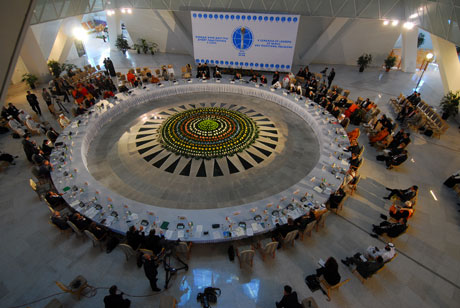
Above: the atrium, and another incredible conference table.
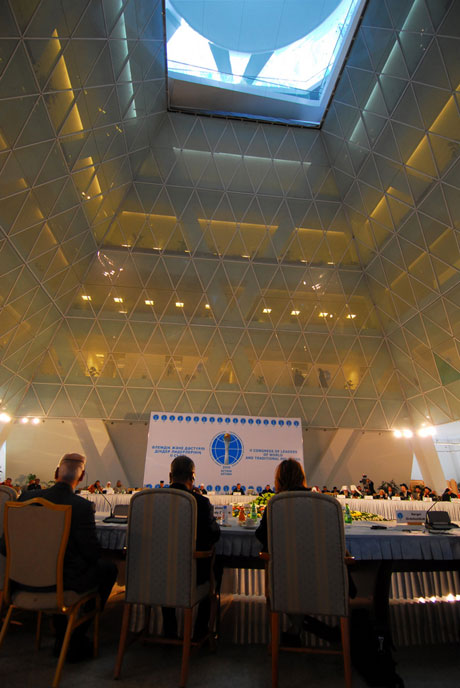
Above: looking up from the atrium towards the upper section. this enormous space is surrounded by walls of rooms, 5 floors high, to be used both for meetings and accommodation.

Above: the opera house beneath the atrium. the domed ceiling sits below the enormous circular table belonging to the room above.
More: Palace of Peace and Reconciliation
Religious leaders met for discussions at the Palace of Peace and Accord
For more detailed info about the pyramid i'd suggest reading this article by ellis woodman.
photos found here, here and here.
Astana

Astana is the capital and second largest city (after Almaty) of Kazakhstan, with an officially estimated population of 750,700 as of November 2008. It is located in the north-central portion of Kazakhstan, within Akmola Province, though politically separate from the rest of the province.
Bayterek "Tall Poplar Tree" or the "Tree of Life"
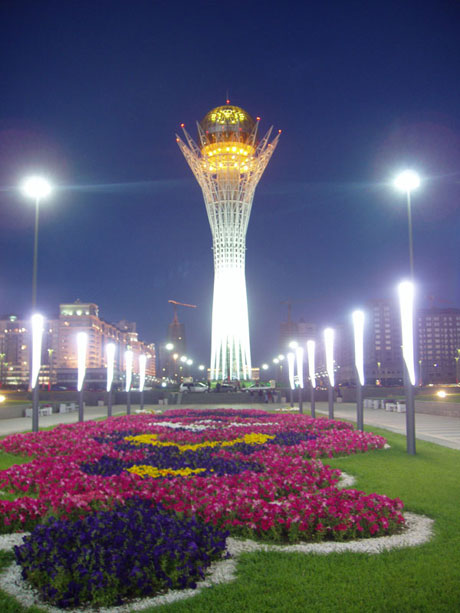

Bayterek is a monument and observation tower in Astana, the capital of Kazakhstan. A tourist attaction popular with foreign visitors and native Kazakhstanis alike, it is a common symbol of the city and itself in turn symbolizes Astana's new status as the capital of Kazakhstan.
The monument is meant to embody a folktale about a mythical tree of life and a magic bird of happiness: the bird, named Samruk, had laid its egg in the crevice between two branches of a poplar tree. The 105m structure consists of a narrow cyllindrical shaft emeshed in flaring white branch-like girders, widening toward the top (the "tree"), where a gold-mirrored 22m-diameter sphere (the "egg") containing the obsevation deck is supported.
The altitude of the deck is 97m, symbolizing the year of the capital-transfer to Astana (1997). From its height it is possible to see much of the newly built city. The viewing platform features a gilded hand print (Alakan) of the right hand of Nursultan Nazarbayev, the first President of the independent Republic of Kazakhstan. An accompanying plaque suggests that visitors place their own hand in the imprint and make a wish; when one does so the Kazakh national anthem plays. In addition to the observation platform, the tower contains a large aquarium and an art gallery.
Read more: Bayterek

Ministry of Transport and Communication in Astana
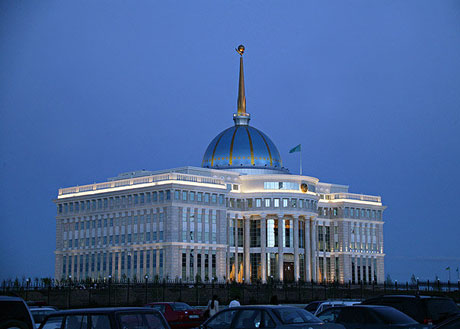
Ak Orda Presidential Palace
More: Astana
A Geostrategy for Eurasia by Zbigniew Brzezinski
From: comw.org
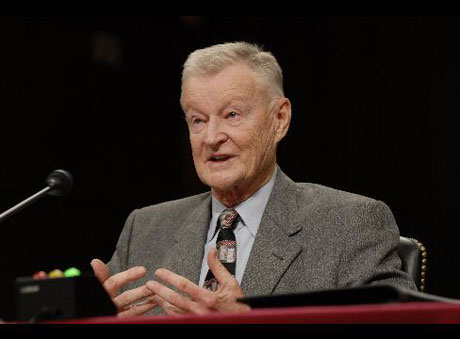
Seventy-five years ago, when the first issue of Foreign Affairs saw the light of day, the United States was a self-isolated Western hemispheric power, sporadically involved in the affairs of Europe and Asia. World War II and the ensuing Cold War compelled the United States to develop a sustained commitment to Western Europe and the Far East. America's emergence as the sole global superpower now makes an integrated and comprehensive strategy for Eurasia imperative.
Eurasia is home to most of the world's politically assertive and dynamic states. All the historical pretenders to global power originated in Eurasia. The world's most populous aspirants to regional hegemony, China and India, are in Eurasia, as are all the potential political or economic challengers to American primacy. After the United States, the next six largest economies and military spenders are there, as are all but one of the world's overt nuclear powers, and all but one of the covert ones. Eurasia accounts for 75 percent of the world's population, 60 percent of its GNP, and 75 percent of its energy resources. Collectively, Eurasia's potential power overshadows even America's.
Eurasia is the world's axial supercontinent. A power that dominated Eurasia would exercise decisive influence over two of the world's three most economically productive regions, Western Europe and East Asia. A glance at the map also suggests that a country dominant in Eurasia would almost automatically control the Middle East and Africa. With Eurasia now serving as the decisive geopolitical chessboard, it no longer suffices to fashion one policy for Europe and another for Asia. What happens with the distribution of power on the Eurasian landmass will be of decisive importance to America's global primacy and historical legacy.
A sustainable strategy for Eurasia must distinguish among the more immediate short-run perspective of the next five years or so, the medium term of 20 or so years, and the long run beyond that. Moreover, these phases must be viewed not as watertight compartments but as part of a continuum. In the short run, the United States should consolidate and perpetuate the prevailing geopolitical pluralism on the map of Eurasia. Tins strategy will put a premium on political maneuvering and diplomatic manipulation, preventing the emergence of a hostile coalition that could challenge America's primacy, not to mention the remote possibility of any one state seeking to do so. By the medium term, the foregoing should lead to the emergence of strategically compatible partners which, prompted by American leadership, might shape a more cooperative trans-Eurasian security system. In the long run, the foregoing could become the global core of genuinely shared political responsibility.
In the western periphery of Eurasia, the key players will continue to be France and Germany, and America's central goal should be to continue to expand the democratic European bridgehead. In the Far East, China is likely to be increasingly pivotal, and the United States will not have a Eurasian strategy unless a Sino-American political consensus is nurtured. In Eurasia's center, the area between an enlarging Europe and a regionally rising China will remain a political black hole until Russia firmly redefines itself as a postimperial state. Meanwhile, to the south of Russia, Central Asia threatens to become a caldron of ethnic conflicts and great-power rivalries.
THE INDISPENSABLE POWER
America's status as the world's premier power is unlikely to be contested by any single challenger for more than a generation. No state is likely to match the United States in the four key dimensions of power -- military, economic, technological, and cultural -- that confer global political clout. Short of American abdication, the only real alternative to American leadership is international anarchy. President Clinton is correct when he says America has become the world's "indispensable nation."
America's global stewardship will be tested by tension, turbulence, and periodic conflict. In Europe, there are signs that the momentum for integration and enlargement is waning and that nationalisms may reawaken. Large-scale unemployment persists even in the most successful European states, breeding xenophobic reactions that could cause French or German politics to lurch toward extremism. Europe's aspirations for unity will be met only if Europe is encouraged, and occasionally prodded, by the United States.
Russia's future is less certain and the prospects for its positive evolution more tenuous. America must therefore shape a political context that is congenial to Russia's assimilation into a larger framework of European cooperation, while fostering the independence of its newly sovereign neighbors. Yet the viability of, say, Ukraine or Uzbekistan will remain uncertain, especially if America fails to support their efforts at national consolidation.
The chances of a grand accommodation with China could also be threatened by a crisis over Taiwan, internal Chinese political dynamics, or simply a downward spiral in Sino-American relations. Sino-American hostility could strain the United States' relationship with Japan, perhaps causing disruption in Japan itself. Asian stability would then be at risk, and these events could even affect the posture and cohesion of a country like India, which is critical to stability in South Asia.
In a volatile Eurasia, the immediate task is to ensure that no state or combination of states gains the ability to expel the United States or even diminish its decisive role. However, the promotion of a stable transcontinental balance should not be viewed as an end in itself, only as a means toward shaping genuine strategic partnerships in the key regions of Eurasia. A benign American hegemony must still discourage others from posing a challenge, not only by making its costs too high, but also by respecting the legitimate interests of Eurasia's regional aspirants.
More specifically, the medium-term goal requires fostering genuine partnerships with a more united and politically defined Europe, a regionally preeminent China, a postimperial and Europe-oriented Russia, and a democratic India. But it will be success or failure in forging broader strategic relationships with Europe and China that shapes Russia's future role and determines Eurasia's central power equation.
THE DEMOCRATIC BRIDGEHEAD
Europe is America's essential geopolitical bridgehead in Eurasia. America's stake in democratic Europe is enormous. Unlike America's links with Japan, NATO entrenches American political influence and military power on the Eurasian mainland. With the allied European nations still highly dependent on U.S. protection, any expansion of Europe's political scope is automatically an expansion of U.S. influence. Conversely, the United States' ability to project influence and power in Eurasia relies on close transatlantic ties.
A wider Europe and an enlarged NATO will serve the short-term and longer-term interests of U.S. policy. A larger Europe will expand the range of American influence without simultaneously creating a Europe so politically integrated that it could challenge the United States on matters of geopolitical importance, particularly in the Middle East. A politically defined Europe is also essential to Russia's assimilation into a system of global cooperation.
America cannot create a more united Europe on its own -- that is a task for the Europeans, especially the French and the Germans. But America can obstruct the emergence of a more united Europe, and that could prove calamitous for Eurasian stability and America's interests. Unless Europe becomes more united, it is likely to become more disunited again. Washington must work closely with Germany and France in building a Europe that is politically viable, remains linked to the United States, and widens the scope of the democratic international system. Choosing between France and Germany is not the issue. Without both these nations, there will be no Europe, and without Europe there will never be a cooperative trans-Eurasian system.
In practical terms, all this will eventually require America's accommodation to a shared leadership in NATO, greater acceptance of France's concerns over a European role in Africa and the Middle East, and continued support for the European Union's eastward expansion even as the EU becomes politically and economically more assertive. A transatlantic free trade agreement, already advocated by a number of Western leaders, could mitigate the risk of a growing economic rivalry between the EU and the United States. The EU's progressive success in burying centuries-old European antagonisms would be wen worth a gradual diminution in America's role as Europe's arbitrator.
Enlargement of NATO and the EU would also reinvigorate Europe's waning sense of a larger vocation while consolidating, to the benefit of both America and Europe, the democratic gains won through the successful end of the Cold War. At stake in this effort is nothing less than America's long-range relationship with Europe. A new Europe is still taking shape, and if that Europe is to remain part of the "Euro-Atlantic" space, the expansion of NATO is essential.
Accordingly, NATO and EU enlargement should move forward in deliberate stages. Assuming a sustained American and Western European commitment, here is a speculative but realistic timetable for these stages: By 1999, the first three Central European members will have been admitted into NATO, although their inclusion in the EU will probably not take place before 2002 or 2003; by 2003, the EU is likely to have initiated accession talks with all three Baltic republics, and NATO will likewise have moved forward on their membership as well as that of Romania and Bulgaria, with their accession likely to be completed before 2005; between 2005 and 2010, Ukraine, provided it has made significant domestic reforms and has become identified as a Central European country, should also be ready for initial negotiations with the EU and NATO.
Failure to widen NATO, now that the commitment has been made, would shatter the concept of an expanding Europe and demoralize the Central Europeans. Worse, it could reignite dormant Russian political aspirations in Central Europe. Moreover, it is far from evident that the Russian political elite shares the European desire for a strong American political and military presence in Europe. Accordingly, while fostering a cooperative relationship with Russia is desirable, it is important for America to send a clear message about its global priorities. If a choice must be made between a larger Europe-Atlantic system and a better relationship with Russia, the former must rank higher.
RUSSIA'S HISTORIC TASK
New Russian ties with NATO and the EU, formalized by the Joint NATO-Russia Council, may encourage Russia to make its long-delayed post-imperial decision in favor of Europe. Formal membership in the Group of Seven (G-7) and upgrading the policymaking machinery of the Organization for Security and Cooperation in Europe -- within which a special security committee composed of America, Russia, and several key European countries could be established -- should encourage constructive Russian engagement in European political and military cooperation. Coupled with ongoing Western financial assistance and infrastructure investment, especially in communication networks, these steps could bring Russia significantly closer to Europe.
But Russia's longer-term role in Eurasia win depend largely on its self-definition. Although Europe and China have increased their regional influence, Russia stiff remains in charge of the world's largest piece of real estate, spanning ten time zones and dwarfing the United States, China, or an enlarged Europe. Territorial deprivation is not Russia's central problem. Rather, Russia must face the fact that Europe and China are already economically more powerful and that Russia is falling behind China on the road to social modernization.
In these circumstances, Russia's first priority should be to modernize itself rather than to engage in a futile effort to regain its status as a global power. Given the country's size and diversity, a decentralized political system and free-market economics would be most likely to unleash the creative potential of the Russian people and Russia's vast natural resources. A loosely confederated Russia -- composed of a European Russia, a Siberian Republic, and a Far Eastern Republic -- would also find it easier to cultivate closer economic relations with its neighbors. Each of the confederated entitles would be able to tap its local creative potential, stifled for centuries by Moscow's heavy bureaucratic hand. In turn, a decentralized Russia would be less susceptible to imperial mobilization.
Russia is more likely to make a break with its imperial past if the newly independent post-Soviet states are vital and stable. Their vitality will temper any residual Russian imperial temptations. Political and economic support for the new states must be an integral part of a broader strategy for integrating Russia into a cooperative transcontinental system. A sovereign Ukraine is a critically important component of such a policy, as is support for such strategically pivotal states as Azerbaijan and Uzbekistan.
Large-scale international investment in an increasingly accessible Central Asia would not only consolidate the independence of the new countries, but also benefit a postimperial and democratic Russia. Tapping the region's resources would increase prosperity and prompt a greater sense of stability, reducing the risk of Balkan-type conflicts. Regional development would also radiate to the adjoining Russian provinces, which tend to be economically underdeveloped. The region's new leaders would gradually become less fearful of the political consequences of close economic relations with Russia. A non-imperial Russia could then be accepted as the region's major economic partner, although no longer its imperial ruler.
EURASIA'S VOLATILE SOUTH
To promote a stable southern Caucasus and Central Asia, America must be careful not to alienate Turkey, while exploring whether an improvement in U. S.-Iranian relations is feasible. If Turkey feels like a European outcast, it will become more Islamic and less likely to cooperate with the West in integrating Central Asia into the world community. America should use its influence in Europe to encourage Turkey's eventual admission to the EU, and make a point of tre-ating Turkey as a European state, provided internal Turkish politics do not take a dramatically Islamist turn. Regular consultations with Ankara regarding the future of the Caspian Sea basin and Central Asia would foster Turkey's sense of strategic partnership with the United States. America should also support Turkish aspirations to have a pipeline from Baku, Azerbaijan, to Ceyhan on its own Mediterranean coast serve as a major outlet for the Caspian sea basin energy reserves.
In addition, it is not in America's interest to perpetuate U.S.-Iranian hostility. Any eventual reconciliation should be based on both countries' recognition of their mutual strategic interest in stabilizing Iran's volatile regional environment. A strong, even religiously motivated -- but not fanatically anti-Western -- Iran is still in the U.S. interest. American long-range interests in Eurasia would be better served by abandoning existing U.S. objections to closer Turkish-Iranian economic cooperation, especially in the construction of new pipelines from Azerbaijan and Turkmenistan. In fact, American financial participation in such projects would be to America's benefit.
Although currently a passive player, India has an important role in the Eurasian scene. Without the political support it received from the Soviet Union, India is contained geopolitically by Chinese-Pakistani cooperation. The survival of Indian democracy is in itself important, in that it refutes better than volumes of academic debate the notion that human rights and democracy are exclusively Western. India proves that antidemocratic "Asian values," propagated by spokesmen from Singapore to China, are simply antidemocratic and not necessarily Asian. India's failure would be a blow to democracy's prospects in Asia and would remove a power that contributes to Asia's balance, especially given China's rise. India should be engaged in discussions pertaining to regional stability, not to mention the promotion of more bilateral connections between the American and Indian defense communities.
CHINA AS THE EASTERN ANCHOR
There will be no stable equilibrium of power in Eurasia without a deepening strategic understanding between America and China and a clearer definition of Japan's emerging role. That poses two dilemmas for America: determining the practical definition and acceptable scope of China's emergence as the dominant regional power and managing Japan's restlessness over its de facto status as an American protectorate. Eschewing excessive fears of China's rising power and Japan's economic ascension should infuse realism into a policy that must be based on careful strategic calculus. Its goals should be to divert Chinese power into constructive regional accommodation and to channel Japanese energy into wider international partnerships.
Engaging Beijing in a serious strategic dialogue is the first step in stimulating its interest in an accommodation with America that reflects the two countries' shared concerns in northeast Asia and Central Asia. It also behooves Washington to eliminate any uncertainty regarding its commitment to the one-China policy, lest the Taiwan issue fester, especially after China's digestion of Hong Kong. Likewise, it is in China's interest to demonstrate that even a Greater China can safeguard diversity in its internal political arrangements.
To make progress, the Sino-American strategic discourse should be sustained and serious. Through such communication, even contentious issues like Taiwan and human rights can be addressed persuasively. The Chinese need to be told that China's internal liberalization is not a purely domestic affair, since only a democratizing and prosperous China has any chance of peacefully enticing Taiwan. Any attempt at forcible reunification would jeopardize Sino-American relations and hobble China's ability to attract foreign investment. China's aspirations to regional preeminence and global status would be diminished.
Although China is emerging as a regionally dominant power, it is not likely to become a global one for a long time. The conventional wisdom that China will be the next global power is breeding paranoia outside China while fostering megalomania in China. It is far from certain that China's explosive growth rates can be, maintained for the next two decades. In fact, continued long-term growth at the current rates would require an unusually felicitous mix of national leadership, political tranquillity, social discipline, high savings, massive inflows of foreign investment, and regional stability. A prolonged combination of all of these factors is unlikely.
Even if China avoids serious political disruptions and sustains its economic growth for a quarter of a century -- both rather big ifs -- China would still be a relatively poor country. A tripling0f GDP would leave China below most nations in per capita income, and a significant portion of its people would remain poor. Its standing in access to telephones, cars, computers, let alone consumer goods, would be very low.
In two decades China may qualify as a global military power, since its economy and growth should enable its rulers to divert a significant portion of the country's GDP to modernize the armed forces, including a further buildup of its strategic nuclear arsenal. However, if that effort is excessive, it could have the same negative effect on China's long-term economic growth as the arms race had on the Soviet economy. A large-scale Chinese buildup would also precipitate a countervailing Japanese response. In any case, outside of its nuclear forces, China will not be able to project its military power beyond its region for some time.
A Greater China becoming a regionally dominant power is another matter. A de facto sphere of Chinese regional influence is likely to be part of Eurasia's future. Such a sphere of influence should not be confused with a zone of exclusive political domination, like the Soviet Union had in Eastern Europe. It is more likely to be an area in which weaker states pay special deference to the interests, views, and anticipated reactions of the regionally dominant power. In brief, a Chinese sphere of influence can be defined as one in which the first question in the various capitals is, "What is Beijing's view on this?"
A Greater China is likely to receive political support from its wealthy diaspora in Singapore, Bangkok, Kuala Lumpur, Manila, and Jakarta, not to mention Taiwan and Hong Kong. According to Yazhou Zhoukan (Asiaweek), the aggregate assets of the 500 leading Chinese-owned companies in Southeast Asia total about $540 billion. The Southeast Asian countries already find it prudent to defer at times to China's political sensitivities and economic interests. A China that becomes a true political and economic power might also project more overt influence into the Russian Far East while sponsoring Korea's unification.
Greater China's geopolitical influence is not necessarily incompatible with America's strategic interest in a stable, pluralistic Eurasia. For example, China's growing interest in Central Asia constrains Russia's ability to achieve a political reintegration of the region under Moscow's control. In this connection and in regard to the Persian Gulf, China's growing energy needs means it has a common interest with America in maintaining free access to, and political stability in, the oil-producing regions. Similarly, China's support for Pakistan restrains India's ambitions to subordinate that country, while offsetting India's inclination to cooperate with Russia in regard to Afghanistan and Central Asia. Chinese and Japanese involvement in the development of eastern Siberia can also enhance regional stability.
The bottom line is that America and China need each other in Eurasia. Greater China should consider America a natural ally for historical as well as political reasons. Unlike Japan or Russia, the United States has never had any territorial designs on China; compared to Great Britain, it has never humiliated China. Moreover, without a viable strategic relationship with America, China is not likely to continue to attract the enormous foreign investment necessary for regional preeminence.
Similarly, without a Sino-American strategic accommodation as the eastern anchor of America's involvement in Eurasia, America will lack a geostrategy for mainland Asia, which win deprive America of a geostrategy for Eurasia as well. For America, China's regional power, co-opted into a wider framework of international cooperation, can become an important strategic asset -- equal to Europe, more weighty than Japan -- in assuring Eurasia's stability. To recognize this fact, China could be invited to the G-7's annual summit, especially since an invitation was recently extended to Russia.
REFOCUSING JAPAN'S ROLE
Since a democratic bridgehead on Eurasia's eastern mainland will not soon emerge, it is all the more important that America's effort to nurture a strategic relationship with China be based on acknowledgment that a democratic and economically successful Japan is America's global partner but not an offshore Asian ally against China. Only on that basis can a three-way accommodation -- one that involves America's global power, China's regional preeminence, and Japan's international leadership -- be constructed. Such an accommodation would be threatened by any significant expansion of American-Japanese military cooperation. Japan should not be America's unsinkable aircraft carrier in the Far East, nor should it be America's principal Asian military partner. Efforts to promote these Japanese roles would cut America off from the Asian mainland, vitiate the prospects for reaching a strategic consensus with China, and frustrate America's ability to consolidate stability in Eurasia.
Japan does not have a major political role to play in Asia, given the regional aversion it continues to evoke because of its behavior before and during World War II. Japan has not sought the kind of reconciliation with China and Korea that Germany sought with France and is seeking with Poland. Like insular Britain in the case of Europe, Japan is politically irrelevant to the Asian mainland. However, Tokyo can carve out a globally influential role by cooperating closely with the United States on the new agenda of global concerns pertaining to development and peacekeeping while avoiding any counterproductive efforts to become an Asian regional power. American statesmanship should steer Japan in that direction.
In the meantime, a true Japanese-Korean reconciliation would contribute significantly to a stable setting for Korea's eventual reunification, mitigating the international complications that could ensue from the end of the country's division. The United States should promote this cooperation. Many specific steps, ranging from joint university programs to combined military formations, that were taken to advance the German-french reconciliation, and later between Germany and Poland, could be adapted to this case. A comprehensive and regionally stabilizing Japanese-Korean partnership might in turn facilitate a continuing American presence in the Far East after Korea's unification.
It goes without saying that a close political relationship with Japan is in America's global interest. But whether Japan is to be America's vassal, rival, or partner depends on the ability of Americans and Japanese to define common international goals and to separate the U. S. strategic mission in the Far East from Japanese aspirations for a global role. For Japan, in spite of the domestic debates about foreign policy, the relationship with America remains the beacon for its international sense of direction. A disoriented Japan, whether lurching toward rearmament or a separate accommodation with China, would spell the end of the American role in the Asia-Pacific region, foreclosing the emergence of a stable triangular arrangement for America, Japan, and China.
A disoriented Japan would be like a beached whale, thrashing helplessly but dangerously. If it is to turn its face to the world beyond Asia, Japan must be given a meaningful incentive and a special status so that its own national interest is served. Unlike China, which can seek global power by first becoming a regional power, Japan can gain global influence only if it first eschews the quest for regional power.
That makes it all the more important for Japan to feel it is America's special partner in a global vocation that is as politically satisfying as it is economically beneficial. To that end, the United States should consider the adoption of an American-japanese free trade agreement, creating a common American-japanese economic space. Such a step, formalizing the growing link between the two economies, would provide a solid underpinning for America's continued presence in the Far East and for Japan's constructive global engagement.
TRANSCONTINENTAL SECURITY
In the long term, Eurasia's stability would be enhanced by the emergence, perhaps early in the next century, of a trans-Eurasian security system. Such a transcontinental security arrangement might involve an expanded NATO, linked by cooperative security agreements with Russia, China, and Japan. But to get there, Americans and Japanese must first set in motion a triangular political-security dialogue that engages China. Such three-way American-Japanese-Chinese security talks could eventually involve more Asian participants, and later lead to a dialogue with the Organization for Cooperation and Security in Europe. That, in turn, could eventually pave the way for a series of conferences by European and Asian states on security issues. A transcontinental security system would thus begin to take shape.
Defining the substance and institutionalizing the form of a trans-Eurasian security system could become the major architectural initiative of the next century. The core of the new transcontinental security framework could be a standing committee composed of the major Eurasian powers, with America, Europe, China, Japan, a confederated Russia, and India collectively addressing critical issues for Eurasia's stability. The emergence of such a transcontinental system could gradually relieve America of some of its burdens, while perpetuating beyond a generation its decisive role as Eurasia's arbitrator. Geostrategic success in that venture would be a fitting legacy to America's role as the first and only global superpower.
Citation: Zbigniew Brzezinski, "A Geostrategy for Eurasia," Foreign Affairs, 76:5, September/October 1997.
COPYRIGHT 1997 Council on Foreign Relations Inc.
Source: comw.org






















